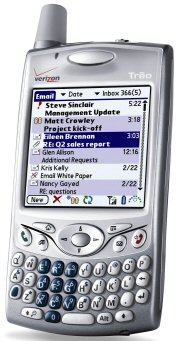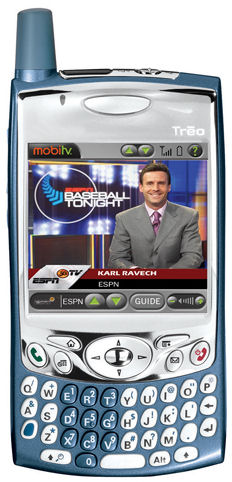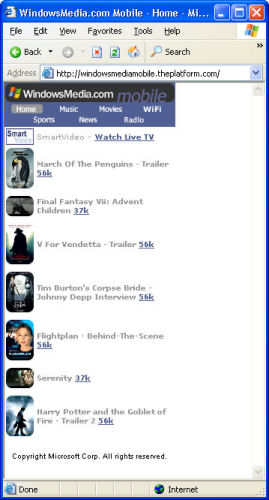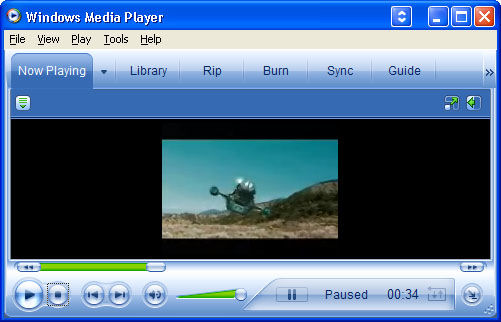Manifest Technology Blog
-- Site:
| Articles
| Galleries
| Resources
| DVI Tech
| About
| Site Map
|
Articles:
| PC Video
| Web Media
| DVD & CD
| Portable Media
| Digital Imaging
| Wireless Media
| Home Media
| Tech & Society
|
Wireless Media:
| Wireless Media Articles
| Mobile Communications Gallery
| Wireless Resources
|
Streaming Video on Mobile Phones (4/2006)
PalmOne Treo
650 - MobiTV
Samsung i730 - Media Player and SmartVideo
by Douglas Dixon
Devices and Data Rates
Palm Treo 650
MobiTV - Service
MobiTV - Technology
Samsung i730 Pocket PC
SmartVideo
Futures
References
TV on your mobile phone? We're not just talking about video clips -- This is
live TV broadcasts -- the big screen now fits in your pocket. Today's mobile
phones have bulked up with PDA functions and processing power, added cameras for
image and video processing, and then boosted transmission speed with 3G / EV-DO
data service -- so Internet streaming video services can now flow directly to
your phone.

 palmOne Treo 650 and Samsung i730
palmOne Treo 650 and Samsung i730
Let's look at how this works on two contrasting platforms -- the Palm Treo
650 running the MobiTV live television service, and the Samsung
SCH-i730 Pocket PC phone running the SmartVideo service. Both of
these platforms were kindly provided by Verizon Wireless, and were tested with
Verizon's data services (www.verizonwireless.com).
The Samsung i730 supports Verizon's faster EV-DO (Evolution Data
Optimized) data service, which receives data (including streaming video) at
up to 10 times faster than the current 1xRTT service -- averaging 400 to 700
Kbps, and peaking up to 2 Mbps (www.verizonwireless.com/b2c/mobileoptions/broadband).
The upload rate is slower (40 to 60 Kbps), comparable to 1X service at average
speeds of 60 to 80 Kbps. Verizon currently charges $49.99 a month for unlimited
data service, for either 1X or EV-DO.


Verizon also offers its V CAST service for playing video-on-demand clips,
priced at $15 per month for unlimited clips (www.getvcast.com).
This runs on new EV-DO handsets using the Microsoft Windows Media Video
format (www.microsoft.com/windows/windowsmedia).
Verizon does not target V CAST to PDA phone platforms, since, as we will see,
these devices are open for installing and connecting to a wide variety of
third-party services.
The Palm Treo 650 is a nicely designed combination of a phone and PDA
device, with more emphasis on a clean integrated experience, and less emphasis
on functionality, connectivity, and media playback. It costs $399.99 though
Verizon, and is available with or without a camera (www.vzwshop.com/treo650).
 palmOne Treo 650
palmOne Treo 650
Just to try to clarify the corporate story, the original Palm, Inc. company
split into two pieces: palmOne (with lowercase "p") is the
hardware company (www.palmone.com), and PalmSource
is the Palm OS software company (www.palmsource.com).
However, in mid-2005, palmOne bought back full rights back for the "Palm"
brand (www.palm.com), and then PalmSource
was acquired by ACCESS, a Japanese mobile software maker (www.access.co.jp,
www.access-us-inc.com).


To further confuse matters, the Palm platform will no longer exclusively use
the Palm OS -- in September 2005 came the announcement that Palm has licensed
the Microsoft Windows Mobile operating system for Treo smartphones, to be
available first from Verizon Wireless.
The Treo is about the same size as the i730, at 4.4 x 2.3 x 0.9 inches, and
weighing 6.3 oz. It has a slightly smaller color touch-sensitive display (1.84 x
1.81), but with higher pixel resolution (320 x 320). This gives room for the
keyboard below the display, instead of the slide-out design of the i730. Users
of older Palms will notice the omission of a separate graffiti screen for pen
text entry. Instead, the interface is designed to allow single-handed use for
navigating and selecting functions with the navigator buttons, and two-thumb use
for the backlit QWERTY keyboard.
The Treo is powered by a Intel PXA270 312 MHz processor, with 23 MB of
user-available non-volatile memory, plus a SD expansion slot for SD, SDIO and
MultiMediaCards. It provides multi-band cellular service, with CDMA or GSM/GPRS
models -- but not 3G EV-DO service. Other connectivity options are beaming via
infrared and Bluetooth, but not Wi-Fi.
The Treo also is available with or without an integrated camera. Eliminating
the camera is important for business use, since you don't want to lose both your
phone and your PDA when cameras are confiscated at corporate sites, court
houses, or even sports events.
The Treo camera shoots at up to VGA resolution (640 x 480). You can shoot
JPEG photos at 640 x 480 or 320 x 240, or capture MPEG-4 video clips at
320 x 240 or 176 x 144 resolution (www.mpegif.org).
The Treo runs the Palm OS 5.4 operating system, with all the usual Palm PDA
applications. For using the camera, there's a set of three integrated
applications: Camera to shoot photos, Camcorder to shoot videos, and Media for
organizing and viewing the resulting images. As with camera phones, you can
share your images though multimedia messages or via the SD card, plus you can
use the Palm functions to HotSync them to a host computer or send with an e-mail
application.
The Treo also includes the RealPlayer application for playing audio
clips, but not video. In addition, the built-in Palm media applications really
are not designed for downloading and viewing your own files. You can download
photos and display slide shows with third-party applications like SplashData
SplashPhoto (www.splashdata.com).
And you can convert and download desktop video and audio clips with applications
like TealPoint TealMovie (www.tealpoint.com),
Kinoma Player for the Palm and Sony PSP (www.kinoma.com),
with native support for MPEG-4, AAC, and JPEG, and MMPlayer (www.mmplayer.com).,
with native playback of MPEG-1, MPEG-2, MPEG-4, and MP3 audio
For online access, the Treo includes the Blazer Web browser. Blazer is
pretty good at rendering arbitrary web pages, including images, either in
compact or wide-screen modes. However, it also does not have built-in media
playback functions. You can use Blazer to download media files in formats
compatible with your supported applications, although it is limed to a maximum
download size of 2 MB. Again, you can use third-party products to augment the
built-in applications.
Beyond playback of local clips, MobiTV from Idetic, Inc. offers live
TV, delivered as steaming video to your handset (www.mobitv.com,
www.idetic.com). The MobiTV service is
available on a wide variety of mobile phones, in the US through Sprint PCS,
Cingular and several regional carriers; in the United Kingdom through Orange UK;
and in Canadia through Rogers and Bell Canada.

 MobiTV service running on the Treo 650
MobiTV service running on the Treo 650
To install MobiTV on the Treo, simply download the Treo application from
Handmark, and sign up for a monthly subscription for $9.99 (mobitv.handmark.com).
The MobiTV service for the Treo includes 31 channels, mostly recognizable
from your cable TV service (www.mobitv.com/channels).
The MobiTV channels include:
- News: MSNBC, NBC, ABC, C-SPAN, CNBC business
- Weather: The Weather Channel
- Sports: ESPN, FOX, MLB.com, plus Vegas Sports and Vegas Scoreline
- Lifestyle: Discovery Channel, TLC, Fashion TV, CNET technology
- Entertainment: Comedy Time, California Music Channel, Country Music Channel
- Kids: Discovery Kids, ToonWorld TV Classics
Depending on your carrier, MobiTV also offers additional channels, including
international news and Spanish and French-language programming.
The Treo version of the MobiTV application provides a very clean and
integrated TV-like experience. The video is framed by the MobiTV controls, with
handy reception and battery indicators on the top, and channel and volume
controls on the bottom. You can surf through the channels, or bring up the
channel guide to jump directly to a specific channel (by number or logo --
there's no additional information on the current programming).
Once you select a channel, there's a delay as the video buffers up, typically
under ten seconds. Then the video just plays continuously. In my testing
commuting around New York City, playback was quite smooth, with occasional
jittering to a shower frame rate (more visible with football action), and very
limited stops to re-load the buffer. The video quality is typically quite
watchable, with visible blockiness if you're looking for it, especially on
underlit scenes or older video (like the cartoons). But when watching
well-produced sports clips, you can see the lines on the football field and even
read the text crawls at the bottom of the screen.
MobiTV uses two different approaches in order to be able to deliver video
playback across a wide variety of mobile phone platforms. For multimedia-capable
phones, it uses RTSP streaming of MPEG-4 video in a 3GPP wrapper,
with AMR or QCELP audio. On a high-end platform like the Treo, MobiTV delivers
video at around 320 x 320 resolution (slightly smaller because it is framed on
the screen) at up to 80 Kbps, with AMR audio at around 8 Kbps.
For less capable phones, MobiTV uses a proprietary HTTP-like protocol
to communicate between its servers and Java client, and deliver the required
format, resolution, and data rate for the specific device. The original source
video is first encoded in a master format at 640 x 480 resolution, using MPEG-4
video and PCM audio. Then, for delivery, the video is trancoded and stepped down
to match the constraints of the target handset. At the low end, the result is Motion
JPEG compression at 1 to 2 frames per second and a data rate of 12 to 15
Kbps.
In addition, the MobiTV server and clients can negotiate to dynamically
adjust the delivery data rate to adapt to network traffic conditions. The
service can switch between three rates per handset, adjusting every several
seconds with each block of delivered video.
MobiTV also has introduced its MobiRadio service, with some 50
channels of commercial-free music streamed to your mobile phone, like satellite
radio or radio on a cable TV service. With the great displays on mobile phones,
MobiRadio can also display text information (station, genre) along with album
art. For delivering this service, MobiTV is using a similar approach, using AAC
at 16 Kbps as the primary delivery format on multimedia phones, and falling back
to AMR and QCELP on lower-end devices. The service is currently mono, with
stereo in the future.
For the next generation of video, MobiTV is working with H.264 video,
which can deliver better-quality video (with less blocky or tearing artifacts),
and at down to one quarter of the data rate. This video looks great at 400 Kbps,
and even down to 100 Kbps on these small mobile phone displays.
However, decoding and playing H.264 video does require next-generation
handsets, which typically also offer access to 3G EV-DO data rates. With the
additional headroom with 3G bandwidth, H.264 video offers interesting
alternatives to better balance quality and data rate. To improve the picture
quality, add more bits per frame to enhance quality, and increase the frame rate
(which also improves the quality by reducing the runs of more heavily compressed
frames between key frames). And it's still possible to adjust and reduce the
data rate to help the cellular carriers manage capacity.
Similarly, MobiTV is looking forward to stepping up to high-efficiency AAC
audio as it becomes available in handsets.
The Samsung SCH-i730 is a Windows Mobile device combining a phone and
Pocket PC PDA, with high-speed EV-DO data service (www.samsungusa.com/wireless).
It features a large 2.8 inch, 240 x 320, color touch screen display, plus a
slide-out QWERTY keyboard for thumb typing. It includes a Intel PXA272
processor, 64MB of built-in memory, a 86 MB SafeStore memory, plus a SDIO
expansion slot. The i730 costs $599.99 though Verizon Wireless, without a camera
(www.vzwshop.com/samsungi730info).
 Samsung SCH-i730
Samsung SCH-i730
This is a very open system, offering direct Internet access so you can surf
the Web, download files, and play clips from anywhere online. Besides the
cellular data service and Bluetooth support, the i730 also provides an 802.11b
WiFi networking connection. With Windows Mobile 2003 Second Edition, you can
surf the Web with Pocket Internet Explorer over EV-DO or WiFi, and simply click
on media files in IE to launch and play them in Pocket Windows Media Player.
Microsoft provides the WindowsMedia.com Mobile video portal for mobile
devices (www.windowsmedia.com/mobile),
which redirects to the video hosting service at windowsmediamobile.theplatform.com).
The site has a rather limited selection of clips, especially compared to all the
full-res content at WindowsMedia.com, with
some recent mobile trailers, music and sports shorts, and some streaming talk
radio.

WindowsMedia.com Mobile video portal, as viewed in
Internet Explorer from a desktop computer
Since these clips all just Windows Media Video 9 format being delivered from
a Web server, you can browse and preview them from any desktop computer as well.
The mobile clips are typically 37 or 56 Kbps (at 160 x 120 or 176 x132
resolution). However, the playback experience on the i730 can be problematical
-- the playback experience is dependent on the site where the clips are hosted,
so sometimes the clips do not launch or refuse to play.

Windows Media Mobile video clip, as viewed in Windows Media
Player from a desktop computer
You also can watch video on the Windows Mobile platform by subscribing to the
SmartVideo service (www.smartvideo.com),
which streams live video and video on demand to Microsoft Media Smartphone
devices over both the current cellular network and new 3G networks. SmartVideo
also is adding support for the Treo 650.


SmartVideo video service playing on the Samsung i730
(Images and logos are the property of their respective
owners)
SmartVideo provides a free 7-day trial service. You can download the
application directly and subscribe from your handheld (see www.smartvideo.com/purchase/pda.html).
The Basic SmartVideo service for $12.95 includes news and finance from ABC, NBC,
CNBC, and MSNBC; the Weather Channel; sports from FOX, College Sports TV, and
Vegas Sports; and a variety of entertainment options from ABC, E!, iFILM, and
Fun Little Movies (www.smartvideo.com/partners.html).
However, only CNBC and MSNBC are actually live TV services, as opposed to video
on demand downloads of pre-edited clips.
SmartVideo also offers premium channels, including Rascals Comedy Classics
for $3.95 a month, DIC Entertainment animations for $4.95, and
"mature" options for Girls Gone Wild ($4.95) and Naked News ($6.95).
SmartVideo is also adding new channels including Spanish, family, and religious
programming.
To access the SmartVideo service on the i730, first launch the SmartVideo
application (to track your subscription), which than launches Internet Explorer
to display the SmartVideo portal and browse the available channels. When you
click (tap) to select a video, IE launches Media Player to stream and display
the actual clip. To minimize load time, the SmartVideo channel Web pages are
rather terse, with just the text names of the channels and a small thumbnail
image, but no descriptive text.
As a result, channel surfing can be a somewhat clunky process, even using the
faster EV-DO service -- with 5 to 10 second round-trip delays in IE to browse
the hierarchical list of channels on the SmartVideo website, and then around 10
seconds to fire up Media Player, connect to the actual video clip, and then
buffer it for playback. Even with a subscription service, I found that sometimes
the channel hierarchy had empty pages, or selected clip just did not play.
Obviously, SmartVideo also uses the Microsoft Windows Media format, with
typical clips compressed using Windows Media Video 8 compression at 41 kbps.
So this is the future -- streaming music and live TV available anywhere,
playing on your mobile device. You don't need to find a WiFi hot spot, with 3G
cellular services like EV-DO these services can stream at 400 to 700 Kbps. But
will this model scale up, as a cellular network designed for short voice calls
feels the strain of millions and then billions of cell phone users start
watching live TV?
Yes, video playback tends to be short form, with people watching brief clips
or updates during downtimes like waiting for a train of airplane. However, it
does peak during major news events, from celebrity trials to national disasters.
And audio service can be continuous as people listen to music in the background,
but at least it runs at a significantly lower data rate.
One answer may be coming from bringing the old-fashioned idea of broadcast TV
transmission to mobile devices. Even as over-the-air television is being
replaced by cable and satellite, the mobile industry is looking to add it to
cellular devices as yet another transmission band. Technology from DVB-H
(Digital Video Broadcasting-Handheld, www.dvb.org)
and QUALCOMM MediaFLO (www.qualcomm.com/mediaflo)
is starting to be deployed in trials to broadcast some 10 to 20 digital channels
to compatible handsets.
So how might video services be delivered? For example, MobiTV is positioning
its service as a universal front-end program guide that offers a single
integrated TV service that could be delivered over all three possible legs of
transport mechanisms to the handset. Each feed then could be transmitted using
the most efficient channel to balance the load for the carrier, in a way that is
transparent to the user. Video on demand and niche broadcast material could be
delivered as a standard unicast data service, as it already is today. The
popular broadcast material could be routed more efficiently though new cellular
multicast equipment that is being developed within the industry. And a handful
of the most popular broadcasts could be transmitted out-of-band in alternative
spectrum through services like DVB-H.
In this way, the cellular carriers have a path for managing bandwidth usage
into the future, even as these services become more popular.
Verizon Wireless
www.verizonwireless.com
Verizon Wireless
www.verizonwireless.com
Verizon Wireless - EV-DO
BroadbandAccess service
www.verizonwireless.com/b2c/mobileoptions/broadband
Verizon Wireless - V CAST
www.getvcast.com
palmOne
www.palmone.com
www.palm.com
PalmSource / Palm OS
www.palmsource.com
ACCESS
www.access.co.jp
www.access-us-inc.com
Palm - Treo 650
www.palmone.com/us/products/smartphones/treo650
Verizon Wireless - Palm Treo 650
www.vzwshop.com/treo650
SplashData SplashPhoto
www.splashdata.com
TealPoint TealMovie
www.tealpoint.com
Kinoma Player
www.kinoma.com),
MMPlayer
www.mmplayer.com
MPEG Industry Forum
www.mpegif.org
MobiTV / Idetic
www.mobitv.com
www.idetic.com
Channels - www.mobitv.com/channels
Handmark - MobiTV subscriptions
mobitv.handmark.com
Samsung - Wireless
www.samsungusa.com/wireless
Verizon Wireless - Samsung i730
www.vzwshop.com/samsungi730info
Microsoft Windows Media
www.microsoft.com/windows/windowsmedia
WindowsMedia.com Mobile portal
www.windowsmedia.com/mobile
windowsmediamobile.theplatform.com
SmartVideo
www.smartvideo.com
Pricing - smartvideo.com/purchase/pda.html
Channels - www.smartvideo.com/partners.html
DVB Project (Digital Video
Broadcasting)
www.dvb.org
QUALCOMM MediaFLO
www.qualcomm.com/mediaflo
|
